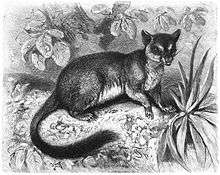Phascogale
The phascogales (members of the eponymous genus Phascogale), also known as wambengers or mousesacks, are carnivorous Australian marsupials of the family Dasyuridae. There are three species: the brush-tailed phascogale (Phascogale tapoatafa), the red-tailed phascogale (Phascogale calura), and the northern brush-tailed phascogale (Phascogale pirata). As with a number of dasyurid species, the males live for only one year, dying after a period of frenzied mating. The term Phascogale was coined in 1824 by Coenraad Jacob Temminck in reference to the brush-tailed phascogale, and means "pouched weasel". All three species are listed as either Near Threatened or Vulnerable by the IUCN.
| Phascogale | |
|---|---|
 | |
| Brush-tailed phascogale (Phascogale tapoatafa) | |
| Scientific classification | |
| Kingdom: | Animalia |
| Phylum: | Chordata |
| Class: | Mammalia |
| Infraclass: | Marsupialia |
| Order: | Dasyuromorphia |
| Family: | Dasyuridae |
| Subfamily: | Dasyurinae |
| Tribe: | Phascogalini |
| Genus: | Phascogale Temminck, 1824 |
| Type species | |
| Didelphis penicillata | |
| Species | |
Phylogeny
The following is a phylogenetic tree based on mitochondrial genome sequences:[1]
| Dasyuromorphia |
| ||||||||||||||||||||||||
Life cycle
.jpg)
Mating generally happens between May and July. All males die soon after mating. Females give birth to about 6 young ones about 30 days after mating. Phascogales do not have the true pouch that is found in most other marsupials . Instead, they form temporary folds of skin - sometimes called a "pseudo-pouch" around the mammary glands during pregnancy. Young stay in this pseudo-pouch area, nursing for about 7 weeks before being moved to a nest where they stay until they are weaned at about 20 weeks of age. Females live for about 3 years, and generally produce one litter.
References
- "The mitochondrial genome sequence of the Tasmanian tiger (Thylacinus cynocephalus)". Genome Res. 19 (2): 213–20. February 2009. doi:10.1101/gr.082628.108. PMC 2652203. PMID 19139089.
- Groves, C.P. (2005). Wilson, D.E.; Reeder, D.M. (eds.). Mammal Species of the World: A Taxonomic and Geographic Reference (3rd ed.). Baltimore: Johns Hopkins University Press. pp. 31–32. ISBN 0-801-88221-4. OCLC 62265494.
External links
• Brush-tailed Phascogale fact sheet: . Also:
• Red-tailed Phascogale fact sheet: . Also: